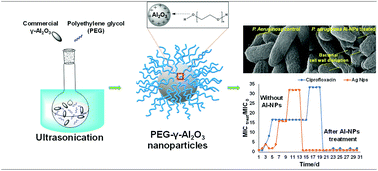An aluminum lining to the dark cloud of silver resistance: harnessing the power of potent antimicrobial activity of γ-alumina nanoparticles†
Abstract
Although a biologically nonessential element in living organisms, aluminum is notably nontoxic to eukaryotic cells and has a venerable history of medicinal use. We demonstrate that polyethylene glycol-coated γ-alumina nanoparticles (Al2O3-NPs) with an average size of 15 nm prepared from a commercial bulk γ-alumina (γ-Al2O3) via the top-down sonication technique exhibit antibacterial activity that is comparable to that of AgNPs against both the Gram-negative drug-susceptible Pseudomonas aeruginosa (DSPA) and multidrug-resistant Pseudomonas aeruginosa (DRPA) bacteria, while the antibacterial activity of such Al2O3-NPs considerably surpasses that of AgNPs against both the Gram-positive methicillin-susceptible Staphylococcus aureus (DSSA) and methicillin-resistant Staphylococcus aureus (MRSA) bacteria. We also demonstrate that the DSPA bacteria sequentially exposed to Al2O3-NPs for 30 days show no indication of resistance development. Furthermore, such Al2O3-NPs can completely overcome the drug resistance developed in the conventional antibiotic ciprofloxacin-resistant and AgNP-resistant mutants without developing Al resistance.



 Please wait while we load your content...
Please wait while we load your content...